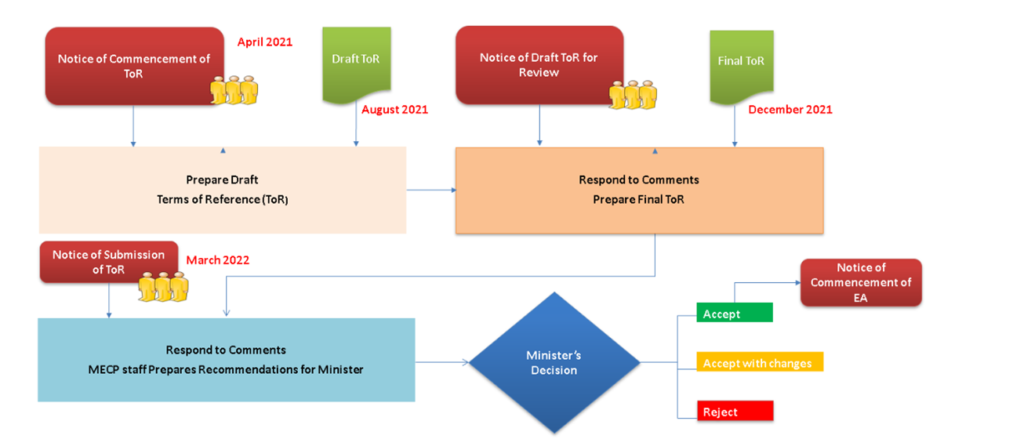Steps In Submitting a ToR (Terms of Reference)
—
What are the steps in submitting a Terms of Reference?
A breakdown of the timeline milestones
The purpose for preparing a Terms of Reference (ToR) is for the proponent to outline how their project’s environmental assessment will meet the requirements of the Environmental Assessment Act and public interests. No assessments are done when preparing a ToR, The ToR describes the work and studies that will be done during the environmental assessment.
Before starting to prepare a ToR, the proponent must first contact the Environmental Assessment Branch of the Ministry of the Environment, Conservation and Parks (MECP). A Project Officer is assigned to the project proposal who will communicate with the MECP during the ToR process and offer advice and guidance to the proponent. The proponent will usually create a website to keep the public informed about the proposal, and to keep a record of notices, reports, and updated versions of the ToR.
Now the proponent is ready to embark upon the process of preparing a ToR.
The following outlines and explains the major milestones towards a final ToR.

Notice of Commencement of ToR
The proponent will prepare a notice announcing the start of the planning process and outlining what is being proposed and how those who are interested can get involved.
Preparing a Draft ToR
The proponent first needs to create a plan setting out how it will consult with interested parties during the ToR preparation. The plan will include information such as consultation methods, who they intend to consult with, how to obtain the input received, and a strategy for resolving issues. Once a consultation plan for the ToR is developed, and the Notice of Commencement has been issued, the proponent can begin drafting the terms of reference. The proponent needs to consult with all interested parties and must record consultation activity in a formal Record of Consultation and submit it with the proposed ToR. Each ToR will be unique, but generally includes the following information:
· Identifies the proponent
· States the purpose and rationale for the project
· Indicates how the environmental assessment will be prepared
· Describes any alternative options
· Describes existing environmental and potential effects of the project
· Outlines the assessment and evaluation process
· Outlines its commitments and monitoring process
· Outlines the consultation plan for the environmental assessment
· Identifies an ability to be flexible and accommodate new situations
Draft ToR
Preparing a draft ToR is important for identifying potential issues that will need to be considered, major gaps in the document that may lead to rejection of the proposal and providing the proponent with early feedback on the proposal. The Project Officer will review the draft ToR to make sure it is complete and offer any further suggestions before submitting it to the ministry.
Notice of Draft ToR for Review
A public notice must be issued when the draft ToR becomes available for review and comments on. Along with notifying the public, the proponent will send copies to interested parties such as Indigenous communities and members of the Government Review Team. Public notice is usually given through a newspaper, mail, or website. A minimum of 30 days is given to review and comment on the draft.
Responding to Comments, Preparinge Final ToR
Comments on the draft ToR are sent to the proponent and the proponent seeks to resolve any issues that are raised by revising the draft and/or responding to comments. These comments and responses will be included in the Record of Consultation that is submitted with the final ToR.
Final ToR
The proponent must give three weeks’ notice to the Project Officer before they intend to submit the ToR to the MECP, and an official submission date will be set.
Notice of Submission of ToR
Notice about the submission of the proposed ToR must be given to the public, and to the clerk of each municipality near the location of the project. The Notice of Submission is given at least two weeks before the official submission date and posted publicly.
Respond to Comments, MECP staff Prepares Recommendations for Minister
After the proposed ToR has been submitted, there is a review period of 12 weeks at the end of which the Minister makes a decision. During the first 30 days, any interested parties can submit comments on the proposed ToR which are sent to the proponent for a response. After the 30 days, the proponent can submit a revised ToR based on the comments provided. The Project Officer will prepare recommendations for the Minister, considering whether the proponent and the ToR:
· Meets requirements of the Environmental Assessment Act
· Meets expectations in the ministry’s Codes of Practice
· Is written in clear and concise plain language
· Identifies and adequately considers the concerns/comments raised
during the review process
· Provides sufficient information to allow the Minister to approve it
· Contains a sufficient Record of Consultation
· Is consistent with the purpose of the Environmental Assessment Act and public interest
Minister’s Decision
At this stage, the Minister is making a decision on the process of conducting the environmental assessment. This is not the final decision on whether the project can start conducting the environmental assessment. The Minister can either approve, amend and approve, or reject the ToR. If the ToR is rejected, there is no process in place to appeal the Minister’s decision, so the proponent would have to either submit a new ToR or abandon the proposal. The Minister will notify the proponent about the decision directly, and the Project Officer will notify the interested parties. The environmental assessment page on the ministry’s website will also list the Minister’s decision.
Notice of Commencement of EA
If the Minister approves the proposed ToR, the proponent can start preparing the environmental assessment with any amendments directed by the Minister. This does not mean the final project will be approved, it just gives the proponent the green light to begin the environmental assessment, which will determine the project’s feasibility.

